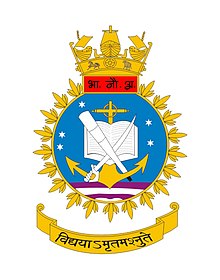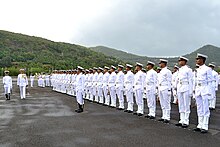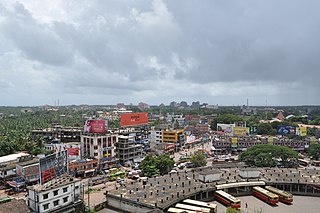
Kannur, formerly known in English as Cannanore, is a city and a municipal corporation in the state of Kerala, India. It is the administrative headquarters of the Kannur district and situated 274 kilometres (170 mi) north of the major port city and commercial hub Kochi and 137 kilometres (85 mi) south of the major port city and a commercial hub, Mangalore. During the period of British colonial rule in India, when Kannur was a part of the Malabar District, the city was known as Cannanore. Kannur is the sixth largest urban agglomeration in Kerala. As of 2011 census, Kannur Municipal Corporation, the local body which administers mainland area of city, had a population of 232,486.
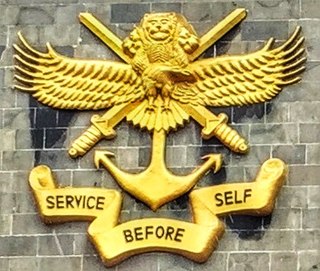
The National Defence Academy (NDA) is the joint defence service training institute of the Indian Armed Forces, where cadets of the Indian Army, Indian Navy, and Indian Air Force train together before they go on to their respective service academy for further pre-commission training. The NDA is located in Khadakwasla, Pune, Maharashtra. It is the first tri-service academy in the world.

Ezhimala, a hill reaching a height of 286 metres (938 ft), is located near Payyanur, in Kannur district of Kerala, South India. It is a part of a conspicuous and isolated cluster of hills, forming a promontory, 38 km (24 mi) north of Kannur (Cannanore). The Indian Naval Academy at Ezhimala is the Asia's largest, and the world's third-largest, naval academy.
The Indian Defence services have established numerous academies and staff colleges across India for the purpose of training professional soldiers in military sciences, warfare command and strategy, and associated technologies.

Indian Air Force Academy, Dundigal is a Defence Service training institute located in Medchal-Malkajgiri district 43 km (27 mi) from Hyderabad, in the Indian state of Telangana.
INS Garuda, is an Indian naval air station located in Kochi, in the state of Kerala. Commissioned on 11 May 1953, it is the oldest operating air station of the Indian Navy.
The Indian Coast Guard Academy will be a military training institute for Indian Coast Guard personnel, which is currently under construction in Mangalore, Karnataka.

Admiral Ronald Lynsdale 'Ronnie' Pereira, PVSM, AVSM was a flag officer in the Indian Navy. He served as the ninth Chief of Naval Staff from 1979 to 1982. He is considered to be one of the architects of the modern Indian Navy.

INS Dega, is a naval air station of the Indian Navy. It is located in Visakhapatnam, Andhra Pradesh on the east coast of India.
Kiran Shekhawat was the first Indian Navy woman officer to be killed in the line of duty. On a flight as an observer with the Indian Navy, the woman Naval officer was martyred in a Dornier crash off the Goa coast on 24 March 2015. Lt. Shekhawat was the wife of another Naval officer, Vivek Chhoker.

INS Shivaji is an Indian naval station located in Lonavala, Maharashtra, India. It houses the Naval College of Engineering which trains officers of the Indian Navy and the Indian Coast Guard. It was commissioned on 15 February 1945 as HMIS Shivaji. It is located close to the Bhushi Dam. It is located on 876 acres of land.
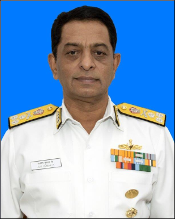
Vice Admiral Ajit Kumar PVSM, AVSM, VSM, ADC is a retired Indian Navy Admiral. He served as Flag Officer Commanding-in-Chief (FOC-in-C) Western Naval Command. He assumed the position on 31 January 2019 after Vice Admiral Girish Luthra's retirement and superannuated on 28 February 2021. Prior to this appointment, he served as Vice Chief of Naval Staff.

Vice Admiral Ravindra Bhartruhari Pandit, PVSM, AVSM is a former Flag Officer of the Indian Navy. He last served as the Commander-in-Chief of the Strategic Forces Command. He assumed the position from Air Marshal Rajesh Kumar. He earlier served as the Chief of Staff of the Western Naval Command, as Commandant of Indian Naval Academy and as the Flag Officer Commanding Western Fleet.

The Commandant of the Indian Naval Academy is the head and in-charge of all the functioning of the Indian Naval Academy. The commandant of the academy is a three-star rank officer holding the rank of vice admiral. He is supported by the deputy commandant, a two-star appointment and the heads of the Academic Wing, Training Wing and the Admin wing.

Vice Admiral Sanjay Jasjit Singh, AVSM, NM is a serving flag officer in the Indian Navy. He currently serves as the Flag Officer Commanding-in-Chief Western Naval Command. He previously served as the 37th Vice Chief of the Naval Staff and as the Deputy Chief of Integrated Defence Staff (Operations) at IDS HQ.
Vice Admiral Kankipati Appala Satyanarayana Zagapathi 'KASZ' Raju, PVSM, AVSM, NM is a former Flag officer in the Indian Navy. He last served as the Flag Officer Commanding-in-Chief Western Naval Command, from 1992 to 1994. A naval aviator, he was part of the Navy's first naval air squadron INAS 300 and was embarked on the Navy's first aircraft carrier INS Vikrant. During the Indo-Pakistani War of 1971, he was the executive officer of the Leopard-class frigate INS Brahmaputra (1957), for which he was awarded the Nao Sena Medal. He later commanded the Western Fleet and the Southern Naval Command.

Vice Admiral Tarun Sobti, AVSM, VSM is a serving Flag officer in the Indian Navy. He currently serves as the Deputy Chief of the Naval Staff. He last served as the Director General Project Seabird. He earlier served as the Flag Officer Commanding Eastern Fleet and as the Deputy Commandant and Chief Instructor at the Indian Naval Academy from March 2019 to January 2021. He was the commissioning commanding Officer of the Kolkata-class guided missile destroyer INS Kolkata (D63).

Rear Admiral Puneet Chadha, VSM is a serving flag officer of the Indian Navy. He currently serves as the Additional Director General of the National Cadet Corps. He previously served as the Flag Officer Commanding Tamil Nadu & Puducherry Naval Area (FOTNA) and as the Deputy Commandant of the Indian Naval Academy. As the last commanding officer of the aircraft carrier INS Viraat (R22), he decommissioned the carrier in 2017.

Rear Admiral Ajay Daniel Theophilus is a serving flag officer of the Indian Navy. He currently serves as the Flag Officer Naval Aviation (FONA) and Flag Officer Goa Naval Area (FOGA). He previously served as the Deputy Commandant of the Indian Naval Academy (INA). He earlier served as the Commanding Officer of INS Hansa and was the commissioning commanding officer of the first Mikoyan MiG-29K naval air squadron INAS 303.
